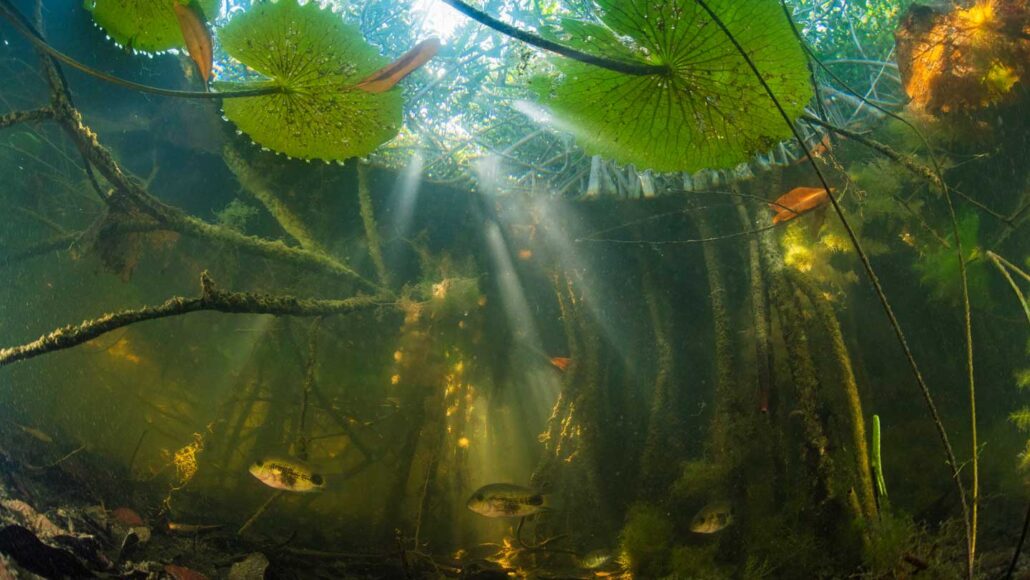Here’s how some sea-loving trees ended up far from the coast
More than 100,000 years ago, the mangroves moved inland due to warming and a rise in sea levels

Fish and other aquatic life find shelter in the underwater roots of red mangroves. This forest is in the San Pedro Mártir River on the Yucatán Peninsula. That’s in Mexico. These trees are part of a “relict ecosystem” that has existed for more than 100,000 years.
Octavio Aburto
Mangroves are tangled trees that typically grow in saltwater along coasts. But some red mangroves thrive deep in the rainforests of Mexico’s Yucatán Peninsula. These plants live in freshwater along the San Pedro Mártir River. That’s nearly 200 kilometers (124 miles) from the sea. Scientists wanted to know how these mangroves got trapped so far inland.
Carlos Burelo was among them. He became curious about these mangroves on a childhood fishing trip there with his dad 35 years ago. Burelo saw that the roots of the mangroves grew above ground. This was different from the other trees, and it fascinated him. Today, Burelo works at Universidad Juárez Autónoma de Tabasco. That’s in Villahermosa, Mexico. This biologist is part of a team that went on to discover where those mangroves came from.
Red mangroves are part of a “relict ecosystem,” they found. (A relict is something that has survived from an earlier period.) This ecosystem formed more than 100,000 years ago. Back then, the world was warmer and sea levels higher. In fact, sea levels reached about 9 meters (30 feet) above today’s levels. As a result, land on what is now the Yucatán Peninsula flooded. That allowed coastal mangroves to move inland. When the world cooled again, the mangroves were stuck far from the coast.
The team shared its findings on October 12. Those results appear in the Proceedings of the National Academy of Sciences.
“The remarkable resilience of these trees is striking,” says Holly Jones. “Although they’re normally adapted to seawater, they’ve survived all this time inland.” That, Jones says, “is incredible.” Jones is a conservation biologist. She works at Northern Illinois University in DeKalb. Jones wasn’t involved in the new study.
Burelo’s team first investigated where the mangroves on the San Pedro Mártir River came from. They started by collecting leaves from these mangroves. The scientists then compared their DNA to those of leaves from coastal mangroves. The coastal trees were growing along the Caribbean Sea and Gulf of Mexico. The DNA helped pinpoint the origins of the mangroves on the San Pedro Mártir River. They had started along the Gulf of Mexico, some 170 kilometers (105 miles) away from the river
The river mangroves’ DNA and their ages also contained clues about when they separated from their coastal relatives. “The red mangroves were isolated for 120,000 years,” says Felipe Zapata. The water and riverbed of San Pedro Mártir is rich in calcium. This helped the mangroves survive here over the years. Zapata is an evolutionary biologist. He works at the University of California, Los Angeles.
The team turned up more evidence that this ecosystem had once been coastal. They discovered 112 other species in this region that are typically found near coasts. These species included orchids and legumes.
With those findings in hand, the researchers decided to look at the soil too. These sediments near the mangroves revealed “exactly what we expected,” says Exequiel Ezcurra — coastal sediments, ocean sediments and ocean fossils. Ezcurra is an ecologist at the University of California, Riverside. In all, the researchers turned up coastal gravels, shells of marine snails and clay sediments rich in shell fragments. They also turned up sediments of coastal dunes and large oyster shells.
These led the researchers to conclude the area that’s now a river merged with the ocean long ago and is now home to a coastal ecosystem.
Computer models of how sea level has changed over time confirmed those findings. The models showed that when sea levels were higher in the past, the ocean merged with the lower basin of the San Pedro Mártir River. That would have been around 150,000 to 130,000 years ago. This pushed red mangroves and other species inland.
This discovery highlights how changes to the past climate have affected the world’s coastlines, Ezcurra says. It also offers a chance to better understand how future sea level rise may affect these ecosystems.







